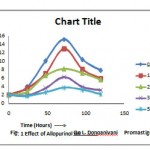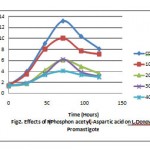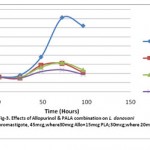How to Cite | Publication History | PlumX Article Matrix
In-Vitro Effects of Allopurinol - PALA Combination on Leishmnia Donovani Promastigotes
Sibaram Paria, Subhasis Maity and Musfiqua Mookerjee
1NSHM College of Pharmaceutical Technology, Kolkata - 700 053 India.
Corresponding Author E-mail: sibram.paria@nshm.com
ABSTRACT: The most effective treatment for visceral leishmaniasis which prevailed since 1930 was Sodium stibogluconate. However resistance to this drug has been a major problem and in India alone 65% of the cases are resistant. Combination therapy with Indolylquinoline derivative and Sodium antimony gluconate has been effective to a greater extent. Our study was taken up with Allopurinol and N- Phosphonacetyl-L-Aspartate (PALA) with an aim to search for effective antileishmanial drugs. Though the drugs did not show very significant antiprotozoal effect when tested individually, however when used in combination it could significantly arrest the growth of Leishmania donovani promastigotes.
KEYWORDS: Leishmania donovani; Leishmaniasis; Allopurinol
Download this article as:| Copy the following to cite this article: Paria. S, Maity. S, Mookerjee. M. In-Vitro Effects of Allopurinol - PALA Combination on Leishmnia Donovani Promastigotes. Biosci Biotechnol Res Asia 2009;6(2) |
| Copy the following to cite this URL: Paria. S, Maity. S, Mookerjee. M. In-Vitro Effects of Allopurinol - PALA Combination on Leishmnia Donovani Promastigotes. Biosci Biotechnol Res Asia 2009;6(2). Available from: https://www.biotech-asia.org/?p=9024. |
Introduction
Leishmnia donovani, the causative organism of Leishmaniasis, a complex disease affecting the Indian subcontinent and East Africa, is also endemic in 62 countries putting a total of 200 million people at risk(Bora,1992).The few therapeutic options registered for visceral leishmaniasis include Amphoteracin B, Antimonials, Miltefosine and Paramomycin (Griensven,2009,). All these drugs used clinically have limitations of price, safety and drug resistance. Hence in this field there is an urgent need for new and improved treatments to replace or complement the existing ones.
Although antileishmanial activities of synthetic compounds are being continually evaluated throughout the world ( Pal et al,2002 and Sundar, et al, 1998), yet the search for newer antileishmanial drugs has not been very worthwhile. In the present study we have taken up Allopurinol which is clinically used against both the primary hyperuricemia of gout and that of secondary level arising due to hematological disorders or in antineoplastic therapy (Goodman-Gilman, 2006) and N- Phosphonacetyl-L-Aspartate ( PALA) which is undergoing clinical trial as an anticancer agent. Our aim is to investigate their possibility of possessing any antileishmanial activity either alone or in combination. Allopurinol is reported to prevent division of protozoal cells when added to a culture of Trypanosoma –cruzi, Leishmania braziliensis(Berens et al;1982).The overall objective of this work is to identify a safe and effective drug combination for combating Leishmaniasis ,in short term therapy.
Materials and Methods
Organism used
Leishmnia donovani Donovan promastigote (MHOM/IN/1978/UR-6) a clinical isolate was used in the study was obtained from Indian Institute of Chemical Biology, Kolkata.
Drugs used
All chemicals were purchased from Sigma chemical Co.USA. Until otherwise stated, N-(Phosphon acetyl)-L-Aspartate (PALA) was obtained as a gift from Prof. G. R. Stark of Stanford University. UK.
Maintenance of strain
The strain was grown on modified Rays blood agar medium (Bera,1987), pH 7.5 at 22-23oC for 24 hrs then the promastigotes were harvested by centrifuging at 1000 x g thrice in cold Tris sucrose salt solution (250 mM sucrose, 20 mM KCl, 1 mM EDTA, 20 mM, Tris. pH7.2) and kept at 4oC until use. Viability of the harvested cells was monitored microscopically by trypan blue exclusion method.
Liquid growth media
The composition of the media is Glucose-1%, Peptone-1%, Sodium chloride-0.5%, Potassium dihydrogen phosphate-0.02%, Sodium hydrogen carbonate-0.01%, Magnesium sulphate-1%, Choline chloride-0.3%, Folic Acid-0.01%, Haemin-0.004%, Ampicillin-0.0013%. Also known as Haemin media as haem is an essential substrate for Leishmnia donovani promastigote in culture.
Experimental
The 72 hrs growth of Leishmnia donovani in solid blood agar was used for study. The growth was washed with normal saline and centrifuged at 3000 rpm for 3 minutes and re-suspended in Phosphate Buffer Saline at pH 7.2 for biochemical studies. 100 ml of liquid haemin media was inoculated with the above culture and the growth was diluted till a count of 1.04 x 106 to 1.92 x 106 was attained which served as initial inoculums. 20ml of inoculum was distributed aseptically into 5 separate 100 ml conical flasks and from each aliquots were taken for confirming initial inoculums size which corresponded to approximately 12/field. The drug was added in four different concentration into four flasks, one flask served as control (without drug) all flasks were incubated at 22.5 oC in B.O.D incubator. At 24 hrs interval aliquots were drawn out aseptically from each flask into sterile tubes. Counts were recorded in hemocytometer using compound microscope at 150X magnification. Such cell counts were taken for 5 consecutive days and for each day an average cell count was recorded (from four different fields prepared).
Results
Effects of Allopurinol on the growth of L. donovani
The determination of cell count was carried out by using hemoctytometer under compound microscope (Chatterjee,1985).The growth was exposed to Allopurinol at four different concentrations of 15µg ,20µg , 30µg & 50µg /ml for as long as 5 days. It was noted that with 50 ug /ml of Allopurinol the cell count was restricted to 4 x 106, at the end of 75 hrs, as compared to the control where the cell count reached 14 x 106. The reduction in the cell count brought about by this drug, in comparison to control (without drug) is represented in Fig-1.
 |
Figure 1
|
Values are expressed as mean values obtained across a set of three independent experiment conducted.
Effect of N-(phosphon acetyl)-L-Aspertate(PALA) on L. donovani
In a similar way when the four different drug concentrations of PALA were exposed to the promastigotes the inhibitory effect was similar at both 30µg and 20µg/ml levels. The effect of PALA on the growth of L. donovani as compared to control is shown in Fig-2
 |
Figure 2
|
Values are expressed as mean values obtained across a set of three independent experiment conducted.
Effects of Allopurinol and PALA combination on L. donovani
Allopurinol and PALA in 2:1 ratio at three different concentrations were exposed to the promastigotes, when the combination was used at 45 µg/ml i.e 30 µg/ml Allopurinol and 15 µg PALA, there was a sharp fall in the count of the promastigotes. The initial count of 1.5 x 106 could only double, under the inhibitory effect of the combination which was much less compared to the control where the maximum count attained was 8 x106. The combined effect on the cell count as compared to control shown in Fig.3
 |
Figure 3
|
Values are expressed as mean values obtained across a set of three independent experiment conducted.
Discussion
The growth inhibitory effect of the drug (Allopurinol) is evident from Fig .2. However the vectoral form is not so suitable for ultimate drug screening. Therefore the pathogenic amastigote form still remains the major target for effective experimental research. It has been noted that the basic mechanism of action involved in case of these drugs is one which interferes with the biosynthetic cycle of purine/pyrimidine ultimately creating blockage in the nucleic acid synthesis. It has already been shown in E.coli that PALA is a powerful analogue of the transition state in the reaction catalyzed by aspartate trans-carbamylase. From the results shown in Fig.3 carried out with PALA, it is clear that this compound also inhibits L.donovani.
Our preliminary combination experiment, involving PALA and Allopurinol clearly showed that at low doses (10mcgAllo+5mcg PALA) distinct synergistic effect was produced, i.e. the inhibition produced by the combined concentration of the two drugs is greater compared to inhibition produced by either of the drugs at equivalent concentration (Fig.2, 3, & 4).
Conclusion
The result of the experiments indicate that there is a distinct possibility of combination therapy in Leishmaniasis .The drug to be identified may not necessarily be PALA and Allopurinol, any other purine/pyrimidine pathway inhibitors may be experimented for this purpose. This preliminary finding opens-up a new direction for screening newer effective drug moiety to combat Leishmaniasis.
Referances
- Bora,D.,Epidemiology of visceral leishmaniasis in India,Natl.Med.J,India,12:62-68,(1992)
- Griensven, J. 4TH World Congress on Leishmaniasis, (2009)
- Pal , C., Raha, M. and Gupta,A., Antimicrobial Agents Chemother, 46: 259-261 (2002)
- Goodman,L.S.,Gilman,A. and GoodmanGilman.,The Pharmacological basis of Therapeutics,Macmillan Publishing company,New York, 6th ed., p-720,(2006)
- Berens,R.L.,Marr,J.J.,Steeleda Cruz,F.S.,and Nelson,D.T.,Antimicrob Agents Chemother October 22(4):657-661,(1982)
- Bera,T.,Mol.Biochem.Prasitol.,23;183-192,(1987)
- Human physiology ,Dr.C.C.Chatterjee;Vol-1,11th edition.Nov,p-171(1985)
- Sundar,S.,L.B.Gupta,V.Rastogi,G.Agrawal and H.w.Murray..Trans.R.Soc.Trop.Med.Hyg.94:200-204,(2000).[Pub Med]
- Sundar,S., and H.W.Murry..J.Infect.Dis.173:762-765,(1996). [PubMed] 10. Bhakuni,V.,S.Kulkarni,V.Ali,U.K.Singh,H.B.Levy,and R.k.Maheshwari..J.Iinterferon Cytokine Res.19:1103-1106.(1999)

This work is licensed under a Creative Commons Attribution 4.0 International License.





